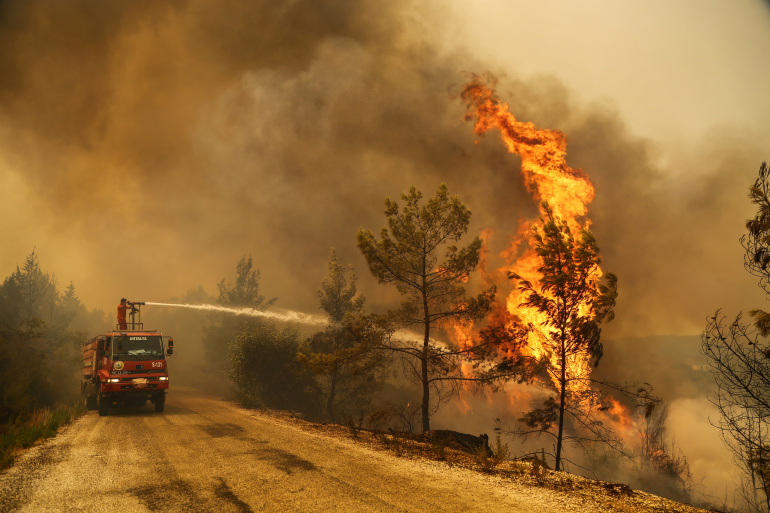On Saturday, Turkey had a sigh of relief. The rainfall became a pacifier as the country was enveloped with wildfires. The fire has now advanced to surrounding areas. Let’s have a look at what the country went through in the last few days and what led to such a mishappening.
Besides fighting the pandemic, the wildfires became a cause of worry for Turkey. The country was in a state of despair as it had been engrossed in wildfires. Over the past seven days, more than 130 wildfires were reported in around 30 Turkish provinces, most of which were along the Mediterranean and the Aegean Sea coasts. Some fires were also reported in areas around Antalya, Mugla, and Marmaris.
What is causing these wildfires?
According to experts, the fuel to Turkish wildfire is hot air from North Africa. This year, the hot air coming from Africa has worsened the European heatwave thereby pushing the Mediterranean on the edge. Other than this, Climate change and rising global warming are in the region are acting as catalysts to aggravate the situation.
Till August 3, at least nine wildfires were still in a burning position across the country. NASA’s earth observatory has revealed that the wildfires are being fed by strong winds, high temperatures (above 40 degrees Celsius), and low humidity.

A larger portion of southern Europe is facing staunch heat for weeks now. The continent has not seen such kind of extremity since the 1980s. Both Greece and Turkey witnessed record-breaking temperatures in July. The temperatures soared to over 45 degrees Celsius. According to meteorologists, a continuous spell of such wildfires in the region is expected.
Antalya, a tourist hotspot in Turkey which had been in the mid-30 degrees Celsius, crossed the temperature to reach over 40 degrees Celsius this week. A similar rise in temperature was observed in Bodrum and Marmaris. Manavgat is among the most affected places in the country.
Politics Amidst the wildfires
The President has accused opposition party members of criticizing Turkey’s lack of adequate aerial firefighting capabilities and inadequate preparedness for large-scale wildfires.
According to Associated Press, the president of Turkey, Recep Tayyip Erdogan, held the municipalities responsible for protecting towns from fires and also said that the central government is not alone responsible for it.
As per the reports, in July, the Turkish Parliament had given permission to the tourism ministry to manage all aspects of new tourism centers. But Turkish officials, including Erdogan, have firmly rejected the rumors that the forests were in danger of cutting and subsequent construction. He has said that the burned forests were protected by the constitution and would be reforested.
Amidst all this, a 2020 report by the Turkish Foundation for Combating Soil Erosion has come up. It shows that 58 percent of Turkey’s forests have been licensed for mining works.
Fire reached the Turkish power plant
The blazes were so powerful that they reached a coal-fueled power plant. People living in nearby residential areas had to be evacuated immediately by the officials. Local reporters said that the wildfires had also caused the evacuation of the nearby seaside area of Oren.

Turkey’s defense ministry said that it was evacuating people by sea as the fires closed in on the plant. The state broadcaster TRT reported that the flames had reached the plant. Strong winds were making the fires unpredictable.
Muhammet Tokat, mayor of Milas to the east of the major resort Bodrum, took to Twitter and wrote, “The situation is very serious. The flames have come to the edge of the thermal power plant.”
After asking for support from Europe, Turkey got two firefighting planes from Spain and Croatia. The planes joined the teams from Russia, Iran, Ukraine, and Azerbaijan to battle the flames.
The tourism sector in Turkey accounts for 5% of its economy. With the wildfires spreading at an alarming rate, the industry is experiencing a further blow after the Coronavirus pandemic.


